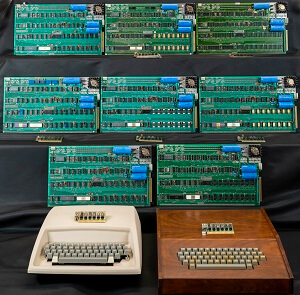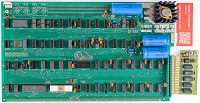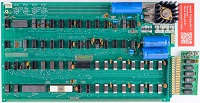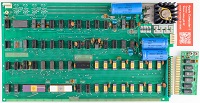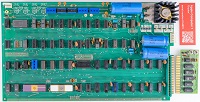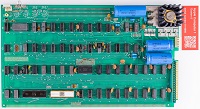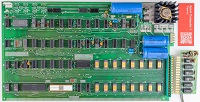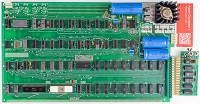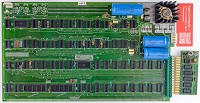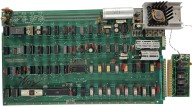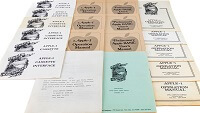I bought my first Apple-1 on eBay in 2015. At the time, I couldn't believe that I had finally acquired this highly coveted and rare computer. The owner was Bob Luther, the author of the book The First Apple. I arranged with him to pick up the computer myself in Alexandria near Washington, DC. I remember the visit very well. We talked for a long time, and later I was invited to the Luthers' home for Halloween, where I experienced for the first time this American tradition of visiting neighbors.
Bob later told me about a collector, David G. Larsen, who runs a museum and owns some of the rarest computers, including three original Apple-1s. I phoned him, and he invited me to Floyd in Virginia. What a great coincidence, because I had rented a Mustang Convertible and wanted to go to the Blue Mountains anyway.
I spent the night at David's, and in the evening he offered me his entire collection. Unfortunately, I was too slow, and so Lonnie Mimms from Georgia bought everything except for two Apple-1s. I later bought one of these Apple-1s from David, and we stayed in contact for many years afterwards.
My first Apple-1 has been on loan to the Deutsches Museum in Munich since 2018.
I bought my second Apple-1 at auction before David Larsen's Apple-1. At an auction in Germany in 2017, an Apple-1 was offered by an American. I went to this auction out of curiosity and to buy a rocket engine, so I had a bidding card. When the Apple-1 was offered, there was only a low starting bid, and no further bids seemed to come in. When it said first, second, I raised my bidding card. The auction went on for what felt like an eternity, and apparently no one got through on the phone or online, so I won the bid. I was immediately surrounded by reporters. That was the end of my “secret” collection. I then decided to talk more or less publicly about my collection and publish information, which ultimately led to many, many contacts and unique offers. At this auction, I met another collector from Germany and another from Austria, and we are still in contact today.
Over time, more Apple-1s were added, and many of them have great memories associated with them.
I got my Apple-1 in the original Byte Shop case from a guy in the Bay Area through a woman from Italy who looked after an Italian's collection of vintage computers. A few years passed before I met the owner in the Bay Area through this mediation, and we came to an agreement.
Another special occasion was the purchase of an Apple-1, which Steve Jobs personally gave to his former best childhood friend, together with another Apple-1. The two boys travelled through the Bay Area in a white and green VW bus, and I had the pleasure of being picked up from Los Angeles airport by this childhood friend. Later, I also bought his second Apple-1. He became very ill, I visited him, and fortunately, he was able to fight the illness successfully.
The acquisition of the Burr Apple-1 in 2019 was a particularly fond memory. Initially, contact was exclusively by email and telephone. The owner was the owner of Computerland, and he was also looking for someone who would appreciate the history and the computer. The computer was sent to me, and it wasn't until two years later that I was able to meet the couple in person. And again, a very nice contact.
The most moving story of an Apple-1 purchase, however, was undoubtedly the so-called Scardino Apple-1. I was asked to add an Apple-1 to the Apple-1 Registry. It was an heirloom from the father to his children, and an appraisal was needed. The family was very nice and sympathetic, and during a Zoom call I offered to do the appraisal for free. A few months passed, and then the family asked me if I would be interested in the Apple-1. And how! This Apple-1 has a fabulous history and is the only manually soldered Apple-1 known to date. All the others were produced by machine using the so-called wave-soldering process. An Apple-1 like this is not for collectors who want a shiny computer that looks like it came off the factory production line, but only for enthusiasts who appreciate the great history. It was the ninth Apple-1 in my collection.
Lucky circumstances
Fortunately, in 2018 I was able to take over the Apple-1 Registry, a directory of all known Apple-1s, from Mike Willegal and expand it considerably.
The passion for collecting and the extremely time-consuming and labor-intensive maintenance of the Apple-1 led to great new contacts and lots of interesting encounters and conversations over the years.
I met Steve Wozniak, Daniel Kottke, Chris Espinosa, Dr. Wendell Sander, professors from Stanford, visited Apple Park in Cupertino, spoke to Paul Terrell, Ron Wayne, and so many other contemporary witnesses. Funny and interesting was the encounter with John Drape aka Cap'n Crunch, whom I met while visiting Daniel Kottke.
Not to forget Jamis MacNiven, the owner of the famous Buck's of Woodside restaurant. This place is considered the birthplace of many Silicon Valley tech companies.
And many others...
